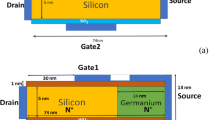Abstract
Analytical model of dielectric modulated trench dual gate junction less field effect transistor (DM_TDJLFET) for biosensing applications is used for the label free detection of bio molecules. The structure of DM-TDGJLFET has two gates which are placed vertical in separated trenches. Threshold voltage sensitivity of neutral as well as charged biomolecules are being studied by this model. Analytical modeling of dual gate and nanowire junction less is used for theoretical analysis off junction less ion sensitive field effect transistor. This FET is used to get the output of nanowire and planar dual gate JLISFET with respect to pH for all regions of operations. This topology successfully brings about designated retention time with larger physical barrier thickness and wider barrier offset length caused by the reduction in band to band tunneling and recombination performance of GaAs and GaSb dual gate junction less metal oxide semiconductor FET is used for the study of high performance switching applications GaAs gallium arsenide is a III-V direct bandgap semiconductor with a zinc blende crystal structure devices. It results a higher leakage power description in both channel materials and low intrinsic delay for thicker layers caused by a substitution amount of energy drop for the predictive analytic model of negative capacitance affect in long channel dual gate junction less transistor. It is based on charge model. The negative capacitance minimizes short channel effects and improves current driving capability, enables both low power operation and more effective transistor size scaling. The sensitivity analysis of negative capacitance junction less transistor is developed in the view of variation in device parameters and the performance with conventional JL devices with TCAD-based investigation of dual gate junction less transistor is used for visualizing the sensitivity of the device against light intensity.
Similar content being viewed by others
Data Availability
The referred papers will be available on request.
References
Bergveld P (1970) Development of an ion-sensitive solid-state device for neurophysiological measurements. IEEE Trans Biomed Eng BME-17(1):70–71
Kim S, Ahn JH, Park TJ, Lee SY, Choi YK (2009) A biomolecular detection method based on charge pumping in a nanogap embedded field-effect-transistor biosensor. Appl Phys Lett 94(24):1–4
Colinge J-P et al (2010) Nanowire transistors without junctions. Nat Nanotechnol 5:225–229
Singh S, Raj B, Vishvakarma SK (2018) Analytical modeling of splitgate junction-less transistor for a biosensor application. Sens Bio-Sens Res 18:31–36
Cuervo A, Dans PD, Carrascosa JL, Orozco M, Gomila G, Fumagalli L (2014) Direct measurement of the dielectric polarization properties of DNA. Proc Natl Acad Sci U S A 111(35):E3624–E3630
Löffler G, Schreiber H, Steinhauser O (1997) Calculation of the dielectric properties of a protein and its solvent: theory and a case study. J Mol Biol 270(3):520–534
Aditya M, Rao KS, Sravani KG et al (2021) Simulation and drain current performance analysis of high-K gate dielectric FinFET. Silicon
Jazaeri F, Barbut L, Sallese J-M (2014) Generalized charge-based model of double-gate junctionless FETs, including inversion. IEEE Trans Electron Devices 61(10):3553–3557
Ban I, Avci UE, Shah U, Barns CE, Kencke DL, Chang P (2006) Floating body cell with independently-controlled double gates for high density memory. Proc. Int. Electron Devices Meeting, pp 1–4
Aditya M, Rao KS (2021) Design and performance analysis of advanced MOSFET structures. Trans Electr Electron Mater
Sasaki KRA et al (2014) Improved retention times in UTBOX nMOSFETs for 1T-DRAM applications. Solid State Electron 97:30–37
Schenk A (1992) A model for the field and temperature dependence of Shockley-read-hall lifetimes in silicon. Solid State Electron 35(11):1585–1596
Shin S, Yoon G, Choi WY (2019) Influence of etch profiles on the leakage current and capacitance of 3-D DRAM storage capacitors. J Semicond Technol Sci 19(2):208–213
Aditya M, Srinivasa Rao K, Sravani K, Guha K (2021) Design, simulation and analysis of high-K gate dielectric FinField effect transistor. International Journal of Nano Dimension 12(3):305–309. https://doi.org/10.22034/ijnd.2021.681554
Pratap Y, Haldar S, Gupta RS, Gupta M (2016) Gate-material engineered junctionless nanowire transistor (JNT) with vacuum gate dielectric for enhanced hot-carrier reliability. IEEE Trans Device Mater Rel 16(3):360–369
Acknowledgements
The authors would like to thank the anonymous reviewers.
Author information
Authors and Affiliations
Contributions
Author 1 (Marupaka Aditya) studied the Analysis of Dual gate Junctionless FinFETs and wrote the paper. Author 2 (K.Srinivasa Rao) studied the application of junctionless FinFETs for bio sensing application. Author 3 (Balaji. B) studied the analysis of junctionless transistor and its drain current characteristics. Author 4 (K.Girija Sravani) studied the application on junctionless transistor for DRAM applications and wrote the paper.
Corresponding author
Ethics declarations
Conflict of Interest
Authors declare no conflict of Interest.
Ethics Approval
The authors declare that they have no known competing financial interest or personal relationships that could have appeared to influence the work reported in this paper.
Consent to Participate
The authors voluntarily agree to participate in this review paper.
Consent for Publication
The authors give the permission to the Journal to publish this review paper.
Additional information
Publisher’s Note
Springer Nature remains neutral with regard to jurisdictional claims in published maps and institutional affiliations.
Rights and permissions
About this article
Cite this article
Soma, U. A Dual Gate Junctionless FinFET for Biosensing Applications. Silicon 14, 8881–8885 (2022). https://doi.org/10.1007/s12633-021-01603-5
Received:
Accepted:
Published:
Issue Date:
DOI: https://doi.org/10.1007/s12633-021-01603-5




